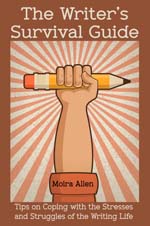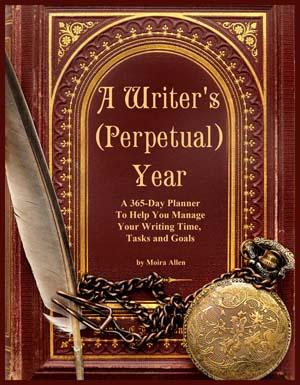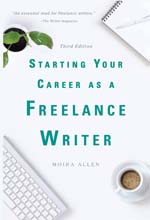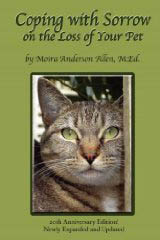 Your Guide to a Successful Writing Career
| |||
|
by Philip Martin
Odd or quirky is, it turns out, naturally interesting. We are drawn to look more closely at something that deviates from the ordinary or expected. We are intrigued by something strange, unpredictable, peculiar, and curious. We want to know more about it. The word odd comes from the Middle English word odde, from Old Norse oddi: a point of land. In other words, it is something that sticks out like a sore thumb. Eccentric, in short, means different. You want to make your story different -- in an intriguing and appealing way. You want your story to stand out from the crowd. This may seem obvious. But many beginner stories are what I'd call centric. They plunk themselves down safely in the middle of the expected; they refuse to venture far from normality. Beginning writers may be afraid or unwilling to challenge, threaten, or puzzle that sense of normalcy in their story. But a story is about something different that happened. A story by definition is eccentric. A good story is not a tennis ball, a perfect sphere to hit back and forth over an imaginary net. It is odd and misshapen, like an old dried apple. It looks different than other apples. It rolls in an unexpected direction. It makes us wonder about its origins. And it catches our interest. Something odd needs to appear early in the pages of a manuscript to catch the attention of agent or editor. Those savvy shoppers of literary works are not looking for familiarity, but for freshness. Remember, there is a stack of fairly equivalent works available to any editor, piled high in stacks or entire rooms of slush-pile submissions. Unless your story quickly offers a quirky aspect, it will quickly be tossed aside. The writer's challenge is to tell a fresh story. As William M. Thackeray (Victorian novelist, author of Vanity Fair), summed it up: "The two most engaging powers of a good author are to make new things familiar and familiar things new." But how do you put a fresh spin on old, familiar things? Eccentricity! Why does this beginning of a great short story, "The Skaters," by Carrie Young, work so well?
Quickly, the story unveils its quirky premise:
- "The Skaters" by Carrie Young, in the collection of short stories titled The Wedding Dress The story begins with a classic "here is a story" start, followed quickly by that odd statement: "if Borghild's had used her good sense, she would have gotten rid of the snow globe." Why? We want to find out. Especially in developing their main characters, too many beginning writers avoid eccentricity in favor of protagonists that are too centric: likable, fairly competent, complete, and satisfactory in most ways. These decent characters don't rock the fictional boat. The only challenges to these nice fellows and gals come from the outside world, not from their own flaws. The beginning writer tends to create a likable character, and then works like the dickens (an inappropriate pun, as Dickens was known for quirky and oddly-named characters, like Scrooge) to throw a plethora of convoluted plot points at them. In short, these amateurish, unpublished novels are plot, plot, and more plot, happening to fairly predictable characters. Inexperienced authors make the mistake of growing to like their protagonists too much; they don't want their hero or heroine to be too challenging or difficult. But the ones we enjoy the most are often the most unpredictable, from The Cat in the Hat to Pippi Longstocking. Some of the best characters are deeply flawed. Think of Sherlock Holmes, one of the most enduring, but not always endearing. Indeed, he was often quite rude and condescending, even to his best friend Dr. Watson. The quirky Holmes was "bohemian." He kept "his cigars in the coal-scuttle, his tobacco in the toe end of a Persian slipper, and his unanswered correspondence transfixed by a jack-knife into the very centre of his wooden mantelpiece. . . ." Holmes was prone to flights of depression, drug consumption, and passionate violin playing. In short, Holmes was a most eccentric character . . . and therefore, unique and memorable. For the sheer fun of it, let's look at some other examples of eccentricity unleashed!
To write the exceptional tale, you need to know more about your genre. In other words, to think outside of the box -- first get to know that box better. Read extensively, so you don't repeat versions of stories. Storytellers are unabashed recyclers, and folk stories are a treasure trove of plots with a lot of life left in them. For example, the SurLaLune fairy tale site (https://www.surlalunefairytales.com) notes at least eleven traditional versions of "Sleeping Beauty" found in traditional lore from Chile to Sweden. And it cites many modern literary adaptations, such as the novels Enchantment by Orson Scott Card, set in modern and ancient Russia; Spindle's End by Robin McKinley; and Briar Rose, Jane Yolen's interpretation set in the Holocaust. Many popular works of modern fiction draw heavily from old tales. Look at the popularity of the novel Cold Mountain, a Civil War tale with echoes of Ulysses' journey home in the Odyssey, and the popularity of the movie O Brother, Where Art Thou?, the Coen brothers' award-winning movie, also based on that mythic journey but now set in Depression-era Mississippi. To recycle, ask two questions: First, what is the core story of the old tale? Then, how would someone in a different time or setting react to that string of events? How might the story change today -- and yet what universal truths might stay the same? Old stories persist because they embody ancient truths, fears, and wonders. As Newbery medalist Nancy Willard said, using a traditional tale is like getting on a wise horse: it knows where to go and how to get there on its own. This leaves you, as the writer, free to concentrate on telling the story well, on making sure your version is fresh, on finding a new twist or interpretation to breathe new life into the performance. Two ideas offer a unique intersection In a 1968 article in The Writer, "Thoughts on Plots," Joan Aiken pointed out that it takes two ideas, colliding, to spark a story.
This tallies with my own experience. . . . Many stories have been told, but unique intersections of any two ideas will be more original. Take a story of a dragon in a cave. Then take a story of a door-to-door vacuum-cleaner salesman. Both have been told. But the combination of the two? Less likely. Think of the number of ideas you might generate by watching a traffic intersection where two busy streets come together. At the intersection, you'll not just see more traffic, but you'll now have the likelihood of interesting episodes as people face more decisions, have to deal with crossing traffic, and end up in surprise situations and, yes, collisions. Phyllis Whitney liked to write stories that involved occupations. The occupation was one story; the romantic suspense tale was the other. Many novels use as their second story that angle of an occupation -- doctor, cowboy, detective -- explored in detail throughout the book and with its own storyline. This offers frequent collisions of the dramatic plot with interesting occupational situations. Consider whodunits such as the Egyptian archeologist mysteries by Elizabeth Peters or the National Park ranger mysteries by Nevada Barr, and any number of similar series. The details of professional practices are interesting in themselves, and they always contribute substantially to the story of the mystery investigation. Aiken herself liked to collect odd clippings from the London Times: "Agile bagpiper with waterproof kilt wanted for party." "Model rhinoceros wanted." "Would exchange gentleman's library for Jersey herd."
Second thread: Michael discovers in a corner of their new home's cluttered garage a pale mysterious creature, seemingly near death. Secretly, Michael tries to help it survive. The two stories at first move independently, but then come together wonderfully, with hints of the angelic imagery of mystical poet William Blake. Many authors have talked about the special serendipity of odd items -- newspaper clippings, curious observations, interesting details about this and that -- noted in a journal or kept in a file, that eventually come together to spark a fresh story. I've advised many would-be authors that while they have a decent single-line story, their manuscript lacks the complexity that might be furnished by the inclusion of a good second story. The main story is just too direct; it suffers from a lack of interesting intersections with another story line.
Creativity is the capacity to think about anything in a new, original, unique way. It's not magic; it's a willingness to try new ideas. True, new ideas may prove to be pointless, a waste of time, stupid, not so new . . . who cares? The dumb idea often leads to the brilliant idea. Thomas Edison was a prolific inventor. He kept his achievement level high by setting a quota for himself: one minor invention every ten days, and a major one every six months. That's not so different from a good writer who produces a short story or article every week or ten days, and several major works a year.
- John Steinbeck Ask questions. Think of metaphors. Einstein flashed on his theory of relativity by thinking about a person riding on a train. Go for walks. Play. Be a child. Try mind-mapping: take a piece of paper and write a central idea in the middle, then work outwards, making free associations with that first word, then with the new words, until the page is full of creative associations, far-flung but connected. Enjoy nonsense. The phrase "What if . . ." is the magic wand of the writer. Ideas come from the ability to daydream and imagine. As Richard Matheson said, his novel The Shrinking Man was "researched" by taking a chair and sitting in his basement for hours. J.R.R. Tolkien kept one scrap of paper, an intriguing phrase that came to him, for no obvious reason, which he jotted down on the back of a student's exam: "In a hole in the ground there lived a hobbit." Years later, he returned to that scrap to begin his children's book, The Hobbit. His imagination had long chewed on the obvious question behind that mysterious phrase: what is a hobbit? Remember to ask the next question, the one that comes after the first creative flash. Neil Gaiman, talking in a 1997 article about playing the "what-if" game, offered this example: "Well, if cats used to rule the world, why don't they anymore? And how do they feel about that?" Creative answers come from constantly asking yourself more questions about your story.
Eccentricity alone is not enough to shape a great story. But it does create interest. It draws the reader in with the promise: here is a story of something odd and amazing. Want to hear about it? The answer: of course! This is true of editors as well as ordinary readers, perhaps even more so. An editor should be viewed as a very jaded person with a very big pile of manuscripts on his/her desk. They read a lot. What might seem fascinating to you may not even flicker the needle on their interest-o-meter. You can never go wrong with leading off with a broad hint that you are about to tell a truly amazing tale. Tempt them with a promise of something quite out of the ordinary. It's also worth noting that the oddities should not be random or unrelated. When the waking Gregor Samsa discovers that he is a giant sentient bug . . . this must pay off in some fashion over the course of the story. As Chekhov pointed out, if there is a gun hanging over the mantle in scene one, it should be fired before the end of the play. The same is true for quirks. I don't know why Long John Silver was originally given a parrot and a wooden leg by Robert Louis Stevenson, but both aspects do play a dramatic role in the Treasure Island story in small but significant ways. Quirks, of course, are just the beginning of your story. Once you have the reader interested, it's up to you to embellish and develop the story.
Excerpted from How to Write Your Best Story This article may not be reprinted without the author's written permission. Philip Martin is a book editor and author with broad experience across diverse aspects of the literary landscape. A former acquisitions editor for The Writer Books, he is now the publisher of Crickhollow Books. Martin is the author of The Writer's Guide to Fantasy Literature and How to Write Your Best Story (from which this article is excerpted); he has also edited The New Writer's Handbook, two volumes of advice for writers. Martin has worked for several years documenting Midwestern folkways, directing oral history research projects and producing museum exhibits, public programs and publications; he has written several books on regional cultural heritage. He lives in Milwaukee, Wisconsin. |
| ||
| |||




